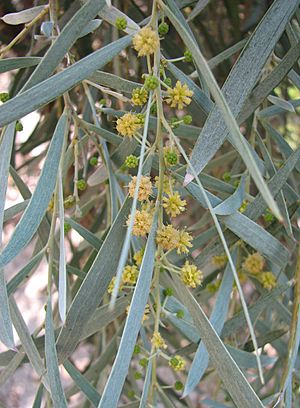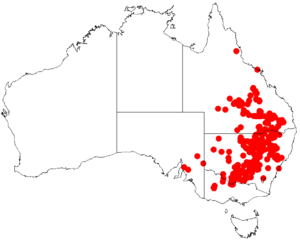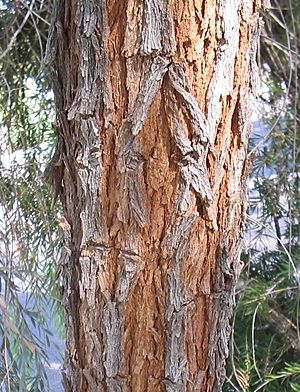Weeping Myall facts for kids
Quick facts for kids Weeping Myall |
|
|---|---|
 |
|
| Scientific classification | |
| Genus: |
Acacia
|
| Species: |
pendula
|
 |
|
| Occurrence data from AVH | |
The Weeping Myall (Acacia pendula) is a special type of wattle tree that grows naturally in Australia. It's also known by other names like true myall or boree. This tree gets its name "weeping" because its branches often hang down, just like someone crying.
Contents
What Does the Weeping Myall Look Like?
This tree usually grows to be about 5 to 13 meters (16 to 43 feet) tall. It can spread out to be 4 to 6 meters (13 to 20 feet) wide. Its branches often hang downwards, giving it a "weeping" look.
The Weeping Myall has hard, cracked grey bark on its trunk and main branches. Its younger branches are covered in tiny hairs. As they get older, they become smooth (this is called glabrous).
The leaves of the Weeping Myall are actually not true leaves. They are flattened leaf stalks called phyllodes. These phyllodes are grey-green and narrow. They are about 4 to 14 centimeters (1.6 to 5.5 inches) long. They have many faint lines running along them.
The tree flowers in summer and autumn, from November to May. It produces bright yellow flowers. These flowers grow in small, round clusters. Each cluster is about 3 to 7 millimeters (0.1 to 0.3 inches) across. They usually have 10 to 20 tiny flowers in them.
After flowering, the tree forms flat, papery seed pods. These pods are green at first and turn brown as they get older. They can be straight or curved. Each pod is 3 to 9 centimeters (1.2 to 3.5 inches) long. They are usually pinched in between each seed. The seeds are often ready to be collected between October and January.
How Was the Weeping Myall Named?
The Weeping Myall was officially described by a botanist named George Don in 1832. He included it in his book about plants.
For a while, in 1987, it was given a different scientific name, Racosperma pendulum. But in 2014, scientists moved it back to the Acacia group.
The second part of its scientific name, pendula, comes from the Latin word pendere. This word means "to fall" or "to hang down." This perfectly describes how the tree's branches hang.
Where Does the Weeping Myall Grow?
The Weeping Myall grows naturally in the dry, remote areas of Queensland, New South Wales, and Victoria in Australia.
In New South Wales, you can find it spread across the inland areas. It often grows on the floodplains of major rivers. It likes to grow in heavy clay soils there.
In all these states, it is found to the west of the Great Dividing Range. This is a large mountain range in eastern Australia. The tree prefers soils made of sand, gravel, silt, and clay. It grows well in places that get about 400 to 600 millimeters (16 to 24 inches) of rain each year.
Why is the Weeping Myall Important?
The Weeping Myall has been useful to people and animals for a long time. In the past, people noticed that farm animals loved to eat its leaves. This was especially true during dry times when other food was scarce. Because animals ate the young trees, the Weeping Myall almost disappeared in some areas.
Today, you can buy Weeping Myall trees as seedlings or seeds. They are great for areas with low rainfall because they can handle dry conditions very well (they are drought tolerant). They can also survive cold temperatures (they are frost tolerant). They grow well in heavy clay soils.
These trees are good for creating shelter or as a windbreak. They also attract native birds, especially parrots, who eat their seeds. The roots of the Weeping Myall have special bumps called rhizobium nodules. These nodules help put nitrogen into the soil, which is good for other plants.
Because of its beautiful blue-grey leaves and hanging branches, the Weeping Myall is popular. People plant it in their gardens in Australia and in other countries like Iran and Kuwait.


